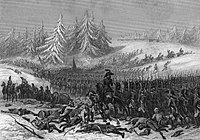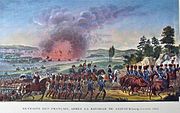Ignác Gyulay
Count Ignác Gyulay de Marosnémeti et Nádaska,Ignácz Gyulay,Ignaz Gyulai(11 September 1763 – 11 November 1831) was a Hungarian military officer, joined the army of theHabsburg monarchy,fought againstOttoman Turkey,and became ageneral officerduring theFrench Revolutionary Wars.From 1806 he held the title ofBan of Croatia.In the struggle against theFirst French EmpireduringNapoleonic Wars,he commanded army corps. At the time of his death, he presided over theHofkriegsrat,the Austrian Council of War.
While fighting against the Turks, Gyulay rose in rank to become a field officer. From 1793 to 1796, he served on the upper Rhine in combat with the armies of theFirst French Republic.In 1799 he led a brigade in Germany and the following year he commanded a division. From 1801 until 1831, he wasProprietor (Inhaber)of a Hungarian infantry regiment.
During theNapoleonic Wars,Gyulay fought in the 1805 campaign against theFirst French Empireand later served his emperor as a negotiator in the peace talks. He commanded an Austrian army corps in the 1809 campaign in Italy. Again leading a corps, he fought at the decisiveBattle of the Nationsin 1813. During the subsequent French campaign in 1814, he led one of the corps in the victorious Allied armies.
Early career[edit]
Born inNagyszeben(Hermannstadt) in the region ofTransylvaniain modern-daySibiu,Romania on 11 September 1763, Gyulay was the oldest son of the AustrianFeldmarschallleutnantCount Sámuel Gyulay de Maros-Németh und Nádaska (1723–1802) and his wife, Baroness AnnaBornemisza de Kászon et Impérfalva(1734–1814).[1]
In 1781, he joined his father's unit, theGyulayInfantry Regiment # 32, as aFähnrich(cadet).[2]He fought in theAustro-Turkish War (1787–91),becoming aMajorin the2nd BanalGrenz InfantryRegiment # 70 on 25 March 1789. Within a year he earned promotion toOberst-Leutnantand commanded a battalion of theGyulayFreikorps.He led this unit in the storm ofCetin Castleon 20 July 1790.[3]
French Revolutionary Wars[edit]
War of the First Coalition[edit]
In 1793, the army assigned Gyulay to the Army of the Upper Rhine under the command ofDagobert von Wurmser.On 13 October that year, he led a brigade underFriedrich von Hotzein theFirst Battle of Wissembourg.[4]In November, he held the village ofMertzwillerfor three weeks in the face of French attacks during theBattle of Haguenau.This action earned him the Knight's Cross of theMilitary Order of Maria Theresain 1794.[3]
In 1793–94, his younger brotherAlbert Gyulayserved in theFlanders Campaign.In 1794, Ignác Gyulay married Maria Freiin von Edelsheim (d. 1814).[5]Their sonFerencz Gyulaiwas born in 1798 and went on to become a high-ranking Austro-Hungarian general.[2]
Gyulay fought on the upperRhinein 1794 and 1795. On 8 April 1795, he becameOberst(colonel) of theBenjowskyInfantry Regiment # 31. However, he continued to lead theGyulayFreikorps. In 1796, he served underMichael von FröhlichinMaximilian Baillet de Latour'sArmy of the Upper Rhine.[3]He fought atRenchenon 28 June and helped cover the subsequent retreat of the Imperial troops.[6]Archduke Charlesordered him to command a force linking the Army of the Upper Rhine and Fröhlich's corps. After theBattle of Ettlingen,Gyulay led Fröhlich's rearguard, earning praise from his superior as a skillful commander of outposts. Later that fall, he greatly distinguished himself in action atMemmingen.For eight hours on 22 September, he held up the advance 6,000 French with only 1,200 soldiers. On 16 May 1797 he was elevated in rank toGeneral-Major.[3]
War of the Second Coalition[edit]
On 20–21 March 1799, Gyulay led a brigade inFriedrich Nauendorf'sdivision at theBattle of Ostrach.He also fought at theFirst Battle of Stockachon 25 March. Soon afterward, he ambushed three battalions and four squadrons of French troops and chased them intoBreisach.[3]

The following year, Gyulay fought at theSecond Battle of Stockachon 3 May 1800 and theBattle of Messkirchon 5 May. After the latter action, he led the rearguard and won a skirmish atGünzburgon 24 May, taking 250 French prisoners. He captured 156 enemy troops in another skirmish atKrumbachon 11 June. These successes led to Gyulay being awarded the Commander's Cross of the Military Order of Maria Theresa and promoted to Feldmarschallleutnant on 29 October.[3]
When the truce ended that fall, Gyulay found himself leading a division inJohann Riesch's corps, which was part ofArchduke John's main army. He fought at theBattle of Ampfingon 1 December. Two days later at theBattle of Hohenlinden,Antoine Richepanse's division marched in front of Riesch's slow-moving left column to envelop the Austrian left-center column. Instead of attacking with crushing strength, Riesch erred by breaking up his two divisions into five small task forces while retaining three battalions and 17 squadrons in reserve. The corps commander then sent each task force along separate forest trails to attack the French.[7]Gyulay fought well, but he had too few troops under his orders to influence the outcome of the battle, which ended in a decisive French victory.[3]
In April 1801, he became the proprietor ofIgnác GyulayInfantry Regiment # 60, a Hungarian unit formed in 1798. He held this post for 30 years until his death.[3]
Napoleonic Wars[edit]
War of the Third Coalition[edit]
In 1805, Gyulay fought in theUlm Campaign,commanding theDanubearmy'sgrenadierreserve inFranz von Werneck's corps.[3]At theBattle of Günzburgon 9 October he commanded a division of seven battalions and 14 squadrons. Ordered to rebuild a bridge across theDanube,he did so but was surprised when a French infantry regiment suddenly appeared and seized the span.[8]Later, he escaped from Ulm withArchduke Ferdinand Karl Joseph of Austria-Esteand others.[9]On 4 November, Gyulai served on a council of war convened byEmperor Francis IIto determine how to saveVienna.Soon afterward, the emperor ordered him to negotiate secretly with EmperorNapoleon I of France.[10]
On 25 November, Gyulay accompaniedJohann Philipp Stadion, Count von Warthausenon a mission to negotiate a treaty with EmperorNapoleon I of France.During the talks Gyulay demanded that France compensate Austria for the loss ofVenetia.A frustrated Napoleon wrote toCharles Maurice de Talleyrand-Périgordthat Gyulay, "talked to me of the Teutonic Order, of the Diet in Ratisbonne, and I don't know what else". Though the discussions continued with Talleyrand, Napoleon became more focused on defeating his enemies and nothing came out of the peace talks.[11]After the disaster at theBattle of Austerlitz,at which Gyulay was not present, he andJohann I Josef, Prince of Liechtensteinnegotiated thePeace of Pressburgwith theFirst French Empire.Emperor Francis II appointed Gyulay theBan of Croatiain 1806, a position he held throughout his lifetime.[3]
War of the Fifth Coalition[edit]

At the outset of theWar of the Fifth Coalition,Gyulay led the IX Armeekorps in Archduke John's army in Italy. As originally organized, the corps consisted of three divisions under Franz Gorup von Bessanez, Christian Wolfskeel von Reichenberg, and Vinzenz Knesevich von Saint Helena. Gyulay commanded 22,290 infantry, 2,400 cavalry, and 86 artillery pieces.[12]The IX Armeekorps fought at theBattle of Sacileon 16 April 1809. During the fighting, the surprise intervention of the IX Armeekorps on the right flank was important in securing the Austrian victory over the Franco-Italian army ofEugène de Beauharnais.[13]His brother Albert led VIII Armeekorps in the same battle.[14]
When EmperorNapoleondefeated Archduke Charles at theBattle of Eckmühlon theDanube,Archduke John was thrown on the defensive. The archduke assigned elements of Gyulay's corps to defendDalmatiaand other places. At theBattle of the Piaveon 8 May, Gyulay led a considerably reduced IX Armeekorps of 12,720 men. As at Sacile, his brother Albert Gyulay led the VIII Armeekorps.[12]Later, he defendedKranjinCarniolawith 14,880 soldiers.[15]After Eugène's army passed to the east in pursuit of Archduke John's army, Gyulay operated againstGraz.On 25 June, his 22,000 troops attacked Jean-Baptiste Broussier's division which was besieging Graz. Broussier retreated into the hills and successfully defended himself until the arrival ofAuguste Marmont's corps on the 27th. Gyulay was able to reprovision the Graz garrison before he withdrew.[16]In the fighting, many of the hastily raised AustrianLandwehrand Hungarian insurrectionsmilitiafled the field. However, Gyulay's Austrian line infantry fought hard and suffered 164 dead and 816 wounded and captured. Reports of French casualties range from 263 to 900.[17]
War of the Sixth Coalition[edit]
When Austria entered theWar of the Sixth Coalition,Gyulay was appointed commander of the Left Wing. His forces included the infantry divisions of Nikolaus Weissenwolf and Alois Liechtenstein, plus the mixed infantry-cavalry division of Karl Folliot de Crenneville. This organization fought at theBattle of Dresdenon 26–27 August 1813, where it fought on the left flank and suffered serious losses.[18]

After a reorganization, Gyulay's formation became known as III Armeekorps, with each infantry division consisting of two, rather than three brigades. The new division commanders were Crenneville, Albrecht Murray de Melgum, and Prince Philipp of Hessen-Homburg. This was the organization used at theBattle of Leipzigon 16–19 October.[19]Before the battle, Gyulay's corps reached a position to the west of Napoleon's Grand Army, potentially cutting off the retreat of the French and their allies. On the 16th, he attacked the suburb of Lindenau and had success at first, forcing MarshalMichel Neyto divertHenri Gatien Bertrand's IV Corps to hold the position.[20]Without this important reinforcement, Napoleon's attacks on the main Austro-Russian army failed. On the 18th, Bertrand drove Gyulay away from Lindenau, clearing the way for Napoleon's retreat.[21]
Gyulay continued to lead the III Armeekorps in the 1814 campaign. He fought at theBattle of La Rothièreon 1 February and defeated the French at theBattle of Bar-sur-Aubeon 27 February. On 20–21 March, he led his corps in action at theBattle of Arcis-sur-Aube.He participated in theBattle of Pariswhen the Allied armies captured the French capital, compelling Napoleon to abdicate in theTreaty of Fontainebleauon 11 April. He received numerous awards, including the AustrianOrder of Leopoldand the Military Honor Cross, the RussianOrder of St. Alexander Nevsky,the PrussianOrder of the Red Eagle- 1st Class, and the BavarianMilitary Order of Max Joseph.[3]
Later career[edit]
From 1814 to 1823, Gyulay commanded the Banal Military Border with Turkey. He became proprietor of the1st BanalGrenz Regiment # 10 and the2nd BanalGrenz Regiment # 11 in 1823, and held these titles for the rest of his life. He was made a Knight of theOrder of the Golden Fleeceand received theOrder of Saint Stephen of Hungary,both in 1830. He briefly sat as president of theHofkriegsrat(Aulic Council) from 7 October 1830 until his death on 11 November 1831 inVienna.[3]
Footnotes[edit]
- ^"Ignác Gyulay von Maros-Németh und Nádaska, Grof".11 September 1763.
- ^abGerman WikipediaIgnácz Gyulay
- ^abcdefghijklSmith-Kudrna,Ignác Gyulay
- ^Smith, p. 58. Smith incorrectly named him Albert Gyulay.
- ^Smith-Kudrna,Ignaz Gyulai.This source gives Maria's birth year as 1740 which is not credible if she gave birth in 1798. It's probably a typo.
- ^Smith, p. 115. TheGyulayFreikorps fought at Renchen.
- ^Arnold, p. 235.
- ^Kagan, p. 409.
- ^Schneid, p. 65.
- ^Rothenberg, pp. 96-97.
- ^Kagan, pp. 560–561.
- ^abBowden & Tarbox, pp. 107-109.
- ^Schneid, p. 74.
- ^Schneid, p. 64.
- ^Bowden & Tarbox, pp. 116-117.
- ^Schneid, p. 92.
- ^Smith, p. 318. Smith writes that the fighting spanned 24 to 26 June.
- ^Millar,Dresden: Army of Bohemia
- ^OSG, Leipzig, p. 7.
- ^Chandler,Campaigns,pp. 926-928.
- ^Chandler,Campaigns,pp. 933-934.
References[edit]
Printed materials[edit]
- Bowden, Scotty & Tarbox, Charlie.Armies on the Danube 1809.Arlington, Texas: Empire Games Press, 1980.
- Chandler, David(1966).The Campaigns of Napoleon.New York: Macmillan.
- Chandler, David.Dictionary of the Napoleonic Wars.New York: Macmillan, 1979.ISBN0-02-523670-9
- Kagan, Frederick(2006).The End of the Old Order: Napoleon and Europe, 1801–1805.Cambridge, MA: Da Capo Press.ISBN0-306-81137-5.
- Operational Studies Group,"Napoleon at Leipzig" Wargame Study Folder.
- Pivka, Otto von.Armies of the Napoleonic Era.New York: Taplinger Publishing, 1979.ISBN0-8008-5471-3
- Rothenberg, Gunther E.(2007).Napoleon's Great Adversary: Archduke Charles and the Austrian Army 1792–1914.Stroud, Gloucestershire:Spellmount.ISBN978-1-86227-383-2.** Schneid, Frederick C.Napoleon's Italian Campaigns: 1805–1815.Westport, Conn.: Praeger Publishers, 2002.ISBN0-275-96875-8
- Smith, Digby(1998).The Greenhill Napoleonic Wars Data Book: Actions and Losses in Personnel, Colours, Standards and Artillery, 1792–1815.Mechanicsburg, Pennsylvania:Stackpole Books.ISBN1-85367-276-9.
External links[edit]
- 1763 births
- 1831 deaths
- People from Sibiu
- Austrian generals
- Hungarian generals
- Hungarian nobility
- Military leaders of the French Revolutionary Wars
- Austrian military leaders of the French Revolutionary Wars
- Austrian Empire commanders of the Napoleonic Wars
- Knights of the Golden Fleece of Austria
- Commanders Cross of the Military Order of Maria Theresa
- Grand Crosses of the Order of Saint Stephen of Hungary
- Grand Crosses of the Military Order of Max Joseph
- Bans of Croatia
- Gyulay family
- Generals of the Holy Roman Empire
- People of the War of the First Coalition

